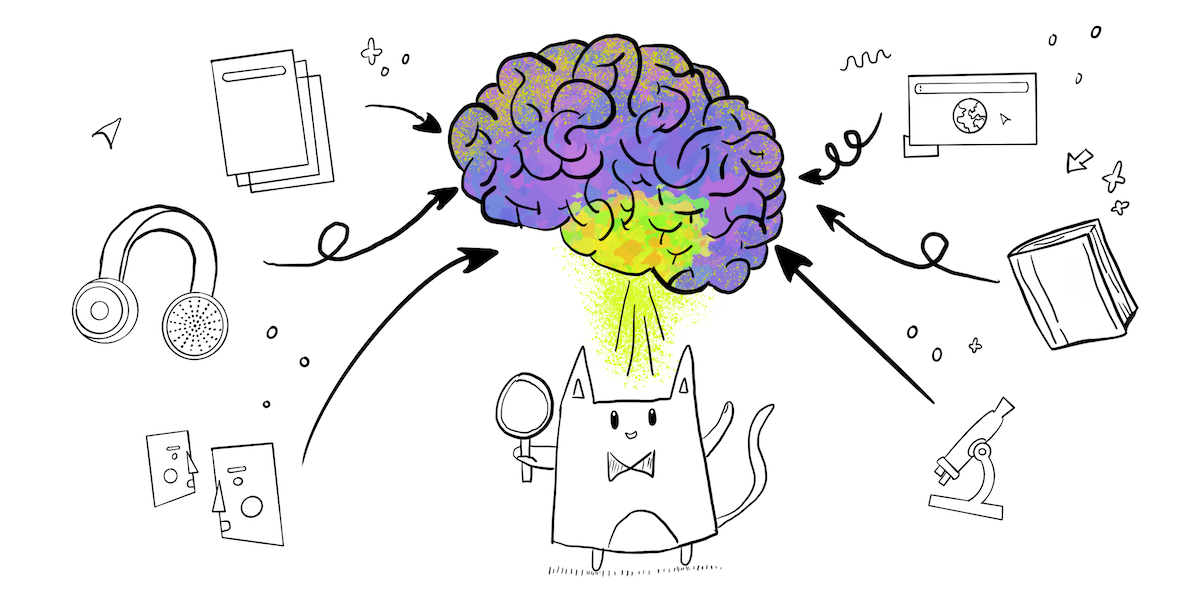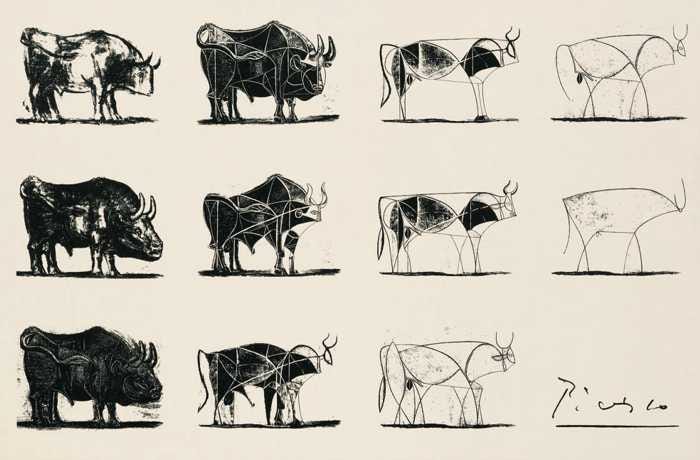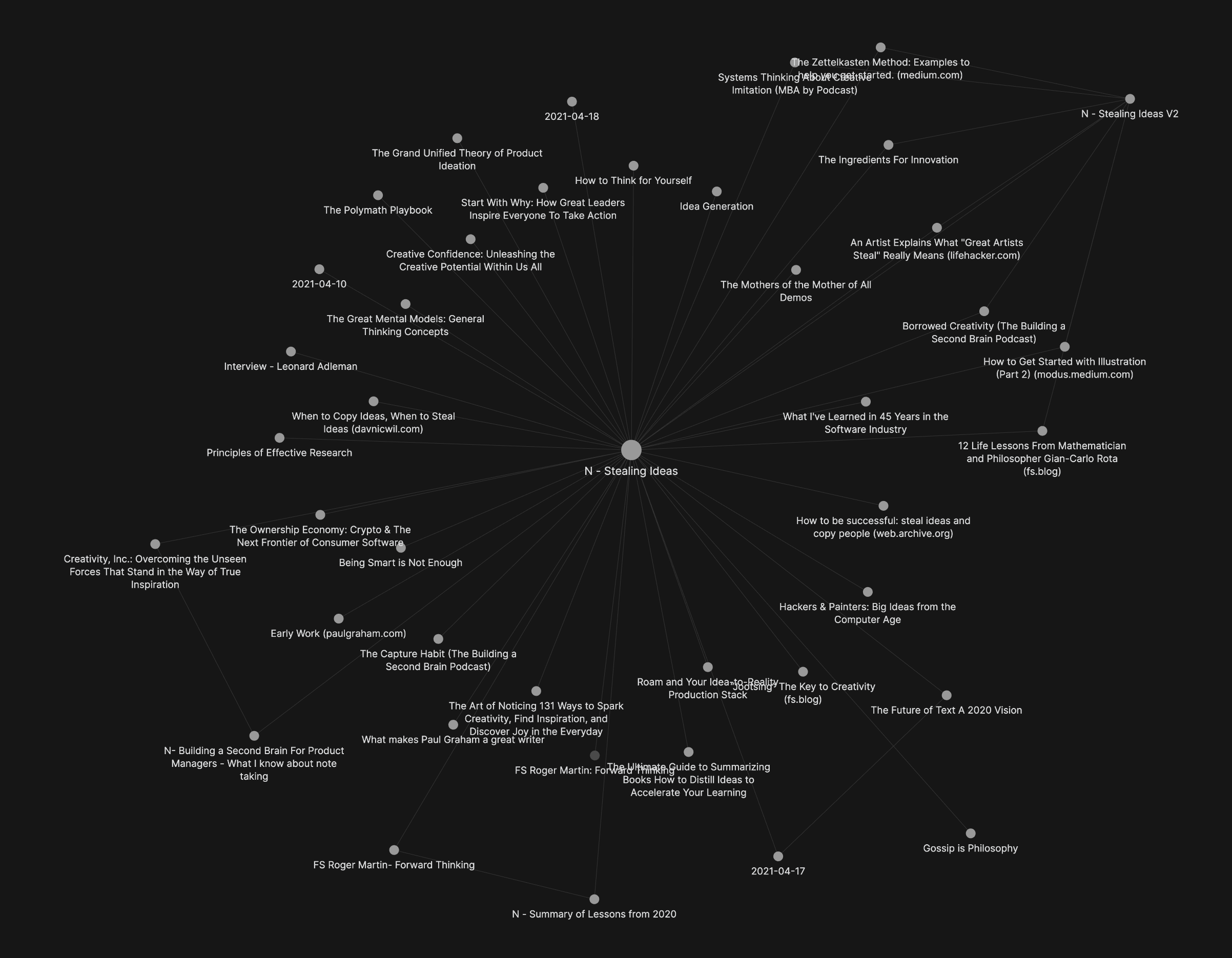Stealing ideas doesn’t have to result in imposter syndrome. If anything, copying helps reveal our most authentic selves.

More than 70% of people in the workplace feel they have experienced ‘imposter’ thoughts at some point in their lives. Since the term ‘Imposter Phenomenon’ was coined by Dr Pauline in 1971 — initially to describe the self-perceived intellectual *phoniness *in high achieving women — the term ‘Imposter Syndrome’ has since become part of the common anxiety vocabulary.
Such feelings of unworthiness of our accomplishments can have a genuine and very prevalent impact on our mental well-being. Imposter syndrome inspires overwork paradoxically in the most talented individuals, which at its worst manifests as stress, depression, and burnout.
Having come from a career in medicine and now product management, I have also experienced these feelings. In both jobs, my underlying fear was the same — that I am not *intelligent *or *creative *enough to do the work. That someone will eventually see through my charade.
What has helped me live with my imposter thoughts is realising that I do not always need to invent something entirely new to prove my worth.
I’ve learned that underpinning many people’s sense of imposter is a feeling of self-doubt, that somehow you are unworthy of your accomplishments by leveraging the help and knowledge of others.
In this article, I will show how copying others is precisely what we have been taught not to do, yet it is exactly what we absolutely must learn to do well. The ability to emulate those whom we admire and whose ideas excite us is probably one of the best tools we humans have to discover our hidden talents.
What follows are the principles I have learned from corporate titans, thieves, historians, and artists on how to steal with integrity to attain my goal: confident humility.
1. Mimicking reveals authenticity
Young professionals often feel pressure to invent something entirely new. That somehow, the act of self-willed creation is a social proof of worth to themselves and others.
From our earliest formal years in education, we are taught that copying was one of the worst things you could do. School teaches us that only original ideas are rewarded unless you are writing an essay or reciting facts, in which case copying from only the most primary sources is tolerated.
By denouncing copying in all its incarnations by pursuing authenticity exclusively through original thought, we inadvertently construct the ball and chain that limits our growth.
“Faïd is the first time I came across that type of a character: someone who lives his criminal life as though it’s out of a screenplay,” — Jean-François Maugard (Retired commander of French National Police special-forces unit)
Though perhaps not the most admirable example, it’s worth considering how infamous master criminal Rédoine Faïd employed the tactic of copying to obtain success.
Faïd, a notorious thief who despises bloodshed, architected a flurry of dazzling heists, blockbuster robberies and escaped two maximum-security prisons. How he orchestrated some of these feats (specifically his helicopter escape) continue to stump French authorities to this day.
“Precisely where Faïd found help is a mystery that police are still trying to unravel” — Adam Gollner (gq.com)
Faïd has said his true mentors were the criminals he’d grown up idolizing onscreen. His greatest crimes are laced with tributes: to Point Break, Heat, and Reservoir Dogs. According to this GQ article, his former lawyer explained in the French tv documentary about Faïd, “He had to create his own methodology. What better way than movies to get inspired and learn the operational modes of criminality?”.
Far from being inauthentic, Faïd has used mimicking to gain the creative confidence to pursue his curiosity and has leveraged it to become an infamous criminal mastermind.
Next time you feel unworthy of an accomplishment, take some time to acknowledge the feeling. Ask yourself, “Where is the source of this feeling coming from?”. Is it one of guilt?
And if so, why?
“Authenticity is invaluable; originality is non-existent.” — Jim Jarmusch, American film director
The art of mimicking is not one of deception, but rather a tool to discover what kind of person a situation requires us to be, and in turn, learn what kind of person we are.
**2. **Nobody starts with nothing
It is one of the ironies of literature that the Thousand and One Nights should owe its global fame to stories — “Aladdin” among them — that never belonged to the original collection in Arabic. — Yasmine Seale (Paris Review)
No idea can truly be 100% yours or truly 100% someone else’s. By the time our prefrontal cortex has interpreted a thought, it can not be helped but transformed into something entirely new.
To find evidence of this, we need to look no further than the citation list of any academic publication. The Lion King *is a kid-friendly version of *Hamlet, and *West Side Story *is *Romeo and Juliet* with slightly less tragedy. But both adaptions have transformed the idea enough to become iconic.
By “standing on the shoulders of giants” i.e. the knowledge of what came before us, we have increased our understanding of the natural world and in turn our ability to create new things within it.
“When you ask creative people how they did something, they feel a little guilty”, Steve Jobs once said, “because they didn’t really do it. They just saw something”.
When pursuing something new, remind yourself that all ideas come from somewhere. Anything of note has been built on perceiving things and connecting the dots to make an idea someone’s own.
The curation of ideas is in itself an act of creation.
3. How to steal ideas respectfully
If there is one golden rule for copying or stealing, it’s probably this: Steal in a way you would like to be stolen from. Ideas come from people, and therefore people are more important than ideas, so treat them as you would like to be treated.
Believing that “great artists steal” may make for a great dorm room poster, but honour exists amongst metaphorical thieves.
When fashion outlet Zara copied pin and badge designs from artist Kurtz, Kurtz called them out. Besides the lack of financial compensation, Kurtz’s real anger was how fast-fashion chains directly copy out of laziness, with no accreditation or attempt to make an idea their own.
One of the lessons here is that if you are inspired by the work of a person, company, or even culture, take the time to credit the original source or develop your own spin on it.
If you find yourself questioning if you have genuinely made someone else’s idea your own, find an informed audience and get them to look at both works. If they say yours is better, congratulations, you have successfully stolen it.
**4. **Great artists steal but know when to copy
It’s important to distinguish the difference between copying or stealing something. As mentioned previously, stealing is best used when the intention is to create something new that you wish to call your own.
On the other hand, copying should be considered a creative stepping stone on the path to stealing. When you replicate an idea or emulate the mannerisms of a personal hero, one should be trying to get inside their heads and uncover the rules of their success.
This is important because you can’t create something really new until we appreciate what rules exist for good reason, and why they need to be broken. Pablo Picasso’s “The Bull” (Le Taureau) is an excellent example of this.

Comprised from a collection of 11 lithographs, “The Bull” begins with realistic depictions of an animal and becomes simplified with each successive illustration. Through reductionism, the bull gradually starts moving towards Cubism becoming more abstract until it can be drawn with just a few lines, yet retain its essence. We are, in a sense discovering Cubism with Picasso as he incrementally breaks the rules of traditional perspective, and begins to employ multiple new ones.
Many creatives, in fact, use copying as part of developing their skills and uncovering talent. Musician Bob Dylan’s first album was a list of cover songs. Filmmaker Hunter S. Thompson retyped the Great Gatsby to acquire that particular style of writing.
I find it helpful to take a page from the Dreyfus model of skill acquisition (Dreyfus, 1980). Specifically, we should appreciate people learn first by following rules until they’ve learned enough to feel confident in experimenting with their own way of doing things.
It’s not lazy to copy; it’s necessary if you want to create your own.
5. Copying as a strategy
In 1994 Microsoft was in trouble; the company was at risk of losing the war for the internet before it had even started.
“Netscape’s entire Get Big Fast strategy had been predicated on making the Navigator browser the de facto standard before competitors like Microsoft noticed.” — Brian McCullough, How the Internet Happened
Netscape at the time dominated with a 70% market share, and a now worried Bill Gates was concerned browsers would displace Windows to become the primary computing interface.
With no browser of their own, Microsoft decided to employ a ruthless strategy of copying Netscape features, which would culminate one year later in the release of the underwhelming V1 Microsoft Internet Explorer.
5 years later (1999) Microsoft leapfrogged the competition entirely with industry-leading features like add-ons (extensions), tabs and faster browsing. By following a strategy of copying, also known as fast following, helped Microsoft accelerate their development and eventually win the first browser war.
“At the point we started Netscape, Microsoft didn’t even know what a web browser was, really” — Mittelhauser
The lesson here is that although we are taught copying is wrong, sometimes the price of NOT copying in the professional world can be downright harmful.
A well-designed website with a joyful user interface, well-considered accessibility and performant architecture is a dense intellectual artefact. You absolutely want to copy its best ideas in the interest of making everyone’s lives better.
As a baker, I could reinvent a sponge cake, but it’s probably a better use of time to focus on the frosting. As a writer, I could write an epic story from scratch, but it’s probably better to start by copying the ‘Hero’s Journey’ outline.
Start new things with the best of what is out there and plan to learn through replication. Like Microsoft, use copying, not with a goal of pure imitation, but rather to learn the game rules in the hope of making something even better.
6. Stealing as a strategy
Stealing at its best is when you can inhabit the mind of those you wish to steal from, and view the problem from their perspective.
When done well, your approach to creation should be filled with multiple reinventions and new perspectives. Done poorly, the final product risks becoming nothing more than a poor imitation.
Your intent should be to use your newfound insights to remix, reinvent and mash-up existing work to create something genuinely new.
For example, Henry Ford and his motor company didn’t actually invent the assembly line or even the automobile itself. But they did combine all these elements in 1908 to create the Model T — the worlds first mass-market car.
Similarly, research shows that academics who combine knowledge from different disciplines are far more likely to produce work that ends up being in the top 1 percent of most cited papers 15 years after publication.
The good news is that assuming the information is presented, humans are really good at combining ideas from diverse sources.
In the pursuit of inspiration, Leonardo da Vinci was famous for successfully using a productivity technique that encouraged his mind to deliberately roam merrily across the disciplines of art, science, engineering and humanities.
So next time you find yourself stuck on a problem or finding a creative solution, try and see if there are ideas outside your field of expertise you can combine into something new.
7. Build a library of stolen ideas
With our newfound appetite for stealing ideas comes a new problem; recollection.
Like a curious Magpie, stealing increases the aperture of our interests, but now we need a nest to store all our shiny nuggets of wisdom and literary quips. We want our future selves to be able to easily find, sort and reflect on these later.
“You have to keep a dozen of your favorite problems constantly present in your mind”, shares physicist Richard Feynman on how to be a genius, “Every time you hear or read a new trick or a new result, test it against each of your twelve problems to see whether it helps. Every once in a while there will be a hit, and people will say: ‘How did they do it? They must be a genius!’”
A solution I find helpful is a framework called Zettelkasten, which I use as part of my Second Brain productivity setup. Zettlekasten is a technique of creating and organising notes to maximise creative output.
The technique was made famous by Niklas Luhmann, a German sociologist who published over 40 books and 400 academic papers. Luhmann credited his achievements to his 90,000 note categorised Zettelkasten, which helped him develop new topics by knitting together ideas into a cohesive whole.

This article, for example, was written thanks to my own Zettelkasten. It combines the insights of around 50 sources, and I’m not quite sure how I would have written this otherwise.
There are a few apps like Obsidian (my favourite), Roam Research, Zettlr and The Archive that have taken this once analogue slip box system, and made it digital for the rest of us. If you want to learn more, I highly recommend this article as a starting point.
One can’t help but wonder how much more productive Luhmann would have been today had he had access to his kind of technology.
8. Ideas are like clues in a detective story — they are all around us
Sometimes I like to pretend I’m Sherlock Holmes. “Pretentious” I hear you cry, but it’s not what you think.
When I walk down the street, speak with a friend, debate a colleague, read a book or painfully watch people navigate a self-service checkout, I believe it’s helpful to always be on the lookout for interesting things.
One could do worse than to mimic the valuable traits from one of literatures most famous observers. I can personally vouch it makes waiting in line more amusing.
Like Holmes, we should view the world much like a scientist observes their field of study, taking note of even the most mundane problems within it. “It’s not enough to react with just an open mind”, psychologists Maggie Toplak and Keith Stanovich say, “you need to be actively open-minded”.
Looking for reasons why we may be wrong about things — not for reasons we must be right — is an excellent way of acknowledging our observations. Doing so allows us the opportunity to revise them.
Try taking time in your day to reflect or simply be ‘present’ in a moment. This can be as simple as taking a shower with no distractions (no music, podcasts or YouTube playing in the background). Write down notes or sketch to reflect on your thoughts and ideas as you do (or after you have left the shower).
The act of simply noticing our surroundings creates an environment of discovery and is a catalyst of creative thought. Like the writer, William Burroughs says, “When you cut into the present, the future leaks out.”.
Our goal should be to use the above techniques to settle in the sweet spot between the extremes of imposter syndrome (underestimating our ability) and its counterpart, the Dunn-Kruger Effect (overestimating our knowledge).
The advice I often hear when I speak with someone about imposter syndrome is to give yourself the benefit of the doubt, but perhaps giving yourself permission to emulate and build upon the successes of others is better.
It’s worth considering that we may not wish to get rid of imposter syndrome entirely. Some studies suggest the same anxiety imposter fear generates is the very thing motivating us to become better workers and learners.
“Great thinkers don’t harbor doubts because they’re impostors.” says psychologist Adam Grant, “They maintain doubts because they know we’re all partially blind.”.
Only through considered copying and stealing of ideas, habits, perspectives and mental models can we learn to appreciate how large our blind spots really are.
A helpful mantra to take away from this is to practice confident humility. Have faith in your capability to achieve your goal, but also have the humility to wonder whether you have the best methods to get there.
“A greater person is the one who accepts the limits of his or her knowledge, and seeks not to be right, but simply truth“ — Epictetus (and many philosophers before and after him)